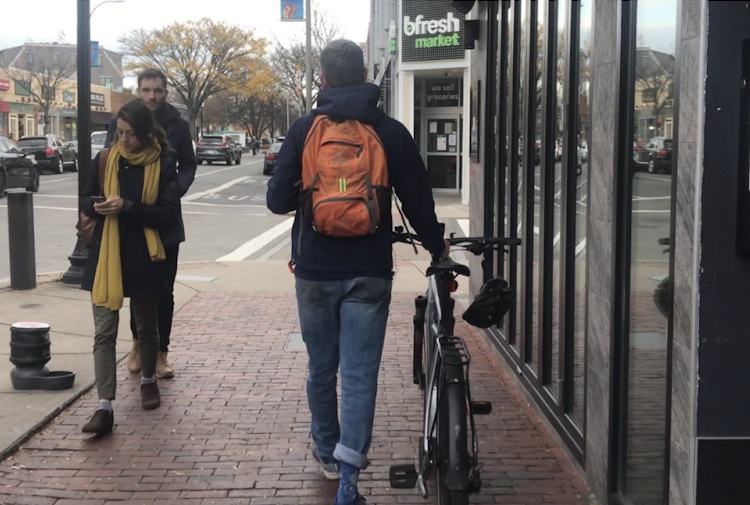“The thing that keeps people from biking is just being scared of doing it.”
Commuting comes in many forms. The greater Boston area is accessible through personal vehicles, buses, trains, rideshare apps and even ferries. However, biking stands out among many residents as a reliable, economic and sustainable way to get around. But in Somerville, some bikers feel that their passion poses a safety risk.
“A driver was trying to crowd me and a bunch of little kids I had taken to a play. He was an older man. He was actually literally trying to hit our bicycles. It was shocking,” Janie Katz-Christy, executive director of the Green Streets Initiative, said.
George Schneeloch, co-founder of the Somerville Bike Safety Group, believes moments like Katz-Christy’s serve as deterrents from biking.
“The thing that keeps people from biking is just being scared of doing it… that they’re going to get into a car crash or something like that,” said Schneeloch.
According to a 2017 study by the League of American Bicyclists, Somerville sees 244 bicycle crashes per 10,000 bikers. That’s more than double the national average—100 crashes per 10 thousand bikers. That same study rated Somerville in multiple categories, including bicycle path engineering, educational programs, mainstreaming bicycling culture, as well as planning future bike safety infrastructure. For example, the category “Enforcement, Promoting safety and protecting bicyclists’ rights” scored 4.2 out of 10 possible points.
More recently, preliminary data from SPD shows 23 bicyclist-involved crashes from Jan. 1, 2020 to Dec. 31, 2020. That number may change as data is audited.
“It’s clear that we have a lot of work to do to educate motorists and to design our streets in a way that are safe for everyone,” Somerville Bicycle Advisory Committee Chair Tom Lamar said.
Lamar added that the Committee has been successful in enacting change.
“We’ve worked with the city to help identify some of the highest crash intersections in Somerville, and one of the highest offenders was Powder House Circle, an old rotary just north of Davis Square. And in [recent months] the city has been completely reconfiguring that,” Lamar said.
The Somerville Bike Safety Group is also taking action. They advocate for creating a network of protected bike lanes with the hope that biking becomes safer for people of all ages and abilities. They support Somerville’s Bicycle Network Plan that details accessible biking routes, according to Schneeloch. Schneeloch anticipates a finalized version by late 2022.
“That plan will show how people of all ages and abilities can get to major destinations in the city like schools, grocery stores, City Hall and so on,” said Schneeloch.
But not everyone is on board. Bicyclist Eric Garnick believes implementing more bike lanes in the city is negatively impacting small businesses in Somerville.
“Here they made parking difficult for businesses, and they constricted traffic into one lane,” said Garnick.
Garnicks’ concern comes from the idea that removing convenient parking spaces in front of businesses will lead to financial losses, especially for small businesses.
He is calling on newly elected Mayor Katjana Ballantyne and other city officials to “not act so quickly; there are a lot of complicated factors — put in better public transportation before you do this, and make people feel there is a genuine alternative to it.”
The Somerville Bicycle Safety group disagrees.
As posted on their website, “studies from New York to Toronto, to Portland, Oregon, to Melbourne, Australia show that bicycles mean business, and when riding a bicycle is made safer and more convenient by adding protected bike lanes and more bicycle parking, stores see increased sales.”
Schneeloch cited College Avenue and Holland Street near Davis square as an example of the city removing some car parking in favor of bike lanes.
“The more that you increase accessibility to a business, the better that is for that business… if a person can pick up a blue bike near the train station and ride a few blocks, and they feel safe doing so, there is potential to increase traffic to a business.”
Eric Colburn has been bicycling in the Somerville area for about 20 years. He supports implementing more protected bike lanes and disagrees they will take away revenue from businesses. Reminding small business owners that Somerville is a growing city.
“We live in a city and most people coming into stores aren’t coming in by car. To people who drive all the time, it might feel like people are coming in by car, and they really aren’t. I stop by stores on my bike all the time,” said Colburn.
Colburn suggested an alternative solution as a form of compromise between those who support implementing protected lanes and those against.
“I’d like to see some more drop-off zones, and I’d like to see more curbed areas that are devoted to short-term parking rather than long-term parking,” said Colburn.
Katz-Christy’s family lives car-free. In fact, her husband started the Somerville Bike Kitchen where community members can repair bikes, learn techniques from peers, and attend events. Katz-Christy has big dreams for the future of Somerville’s biking scene.
“Elm Street is so ripe for a bike lane. It’s wide. It’s really wide. It should be a beautiful boulevard with trees and a bike lane,” she said.
Katz-Christy is hopeful that Mayor Ballantyne and Boston Mayor Michelle Wu assist in the push for more bike infrastructure.
“The more infrastructure, the more people will be thrilled to feel the wind in their hair and be riding,” she said.
Somerville is a growing city. The 2020 census showed that the population grew seven percent since 2010. With more people living in the city, advocates are calling for more bike safety initiatives.
While a common ground between those in support and those against the implementation of bike lanes has yet to be found, some Somerville drivers and business owners are calling for the city to take immediate action as the population continues to grow.
This article was produced in partnership with Professor Gino Canella’s grassroots journalism class at Emerson College. It is syndicated by the MassWire news service of the Boston Institute for Nonprofit Journalism. If you want to see more reporting like this, make a contribution at givetobinj.org.





